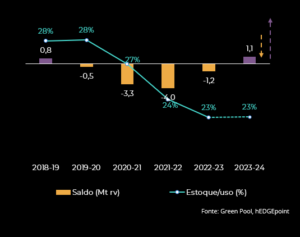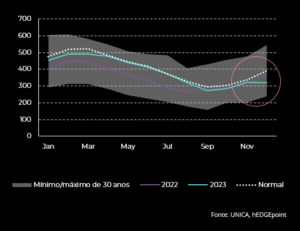
With a delicate global scenario, mainly due to the situation in India, the Brazilian nation has the potential to balance supply and demand at a global leve

With a delicate global scenario, mainly due to the situation in India, the Brazilian nation has the potential to balance supply and demand at a global level. The country will therefore be key in influencing sugar prices.
Aspects such as the weather, macroeconomics and geopolitical conflicts also influence the sugar market, intensifying volatility. In this context, it is essential to adopt hedging tools capable of managing risks.
Follow our exclusive content and understand how Brazil can be a key player in this market in 2024. Happy reading!
Currently, trade flows remain tight in the sugar market, considering the window between the first quarter of 2024 and the first quarter of 2025. In other words, we’re looking at the 23/24 cycle and the start of the 24/25 cycle.
In terms of the global balance, the 23/24 harvest from October to September should be in surplus, a direct reflection of the Brazilian record. On the other hand, with the deterioration of growing conditions in the Center-South, a deficit is currently expected.
In this case, any worsening of the already tight availability conditions could trigger price increases. While the situation has not been so favorable for Brazil, the results expected for the country are still at the upper limit of recent years. However, when compared to the 23/24 season, the 24/25 harvest represents a significant reduction.
As far as the Northern Hemisphere is concerned, the climate is expected to be more favorable for sugarcane development, especially if La Niña is not so intense. In this scenario, the phenomenon would cooperate with the monsoon regime.
As a result, producing countries in Southeast Asia, such as India and Thailand, may have greater availability. In the case of the former, this will not necessarily lead to exports, as they will be dependent on three issues:
● Surplus volume after a resumption of the ethanol program.
● Price environment.
● Government measures.
At the current crushing rate, Thailand could reach a production of 8.5 million tons of sugar in 23/24. As for the 24/25 season, given the favorable weather conditions, it won’t be surprising if the country reaches around 10 million tons of sugar. If these figures are confirmed, there could be an increase in exports.
Global sugar balance (mt rv-outset)

Brazil had its biggest harvest in 23/24, with record sugar cane numbers and is expected to crush 655 million tons by . In November, December and early January, production was excellent, with figures higher than usual for the fortnight.
In this sense, the country is able to meet international market demand at a time of tighter supply in the Northern Hemisphere. The Center-South region was extremely important for the current season’s figures, with favorable weather conditions that contributed to cane productivity and crushing.
However, for 24/25, the weather brings the greatest volatility to the sugar market. Its impact remains the most significant risk factor for the 24/25 harvest in Brazil and could contribute positively to the bullish outlook.
February’s rainfall and humidity, coupled with the unfavorable weather in the first half of March, dampened optimism about sugarcane volume projections. The northern part of the region was significantly more affected than the south.
Therefore, estimating the real impact of the drought remains difficult and allows us to point to a sugarcane production of 605.8 million tons. Of this figure, 41.75 million tons would be destined for sugar production.
Average soil moisture in CS (mm in top 0-1.6 m soil)

The reduction in productivity could reach 8.4%, which translates into an average TCH (tons of cane per hectare) of almost 79 t/ha. In this way, the recent drought in the Center-South and the reduction in yields could lead to a bullish factor in prices. On the other hand, an improved harvest in the Northern Hemisphere could boost the bearish factor.
There are three main factors that can accentuate volatility in the sugar market. Below, we explain each of them.
It’s important to bear in mind that sugar production depends considerably on climatic conditions. The year 2024 brings the risk of a change from El Niño to La Niña, with the possibility of this climatic event starting in July.
The upward or downward trend will depend on the intensity of the phenomenon. If it’s more subtle, it could contribute to a higher concentration of sucrose in Brazil and cause above-average rainfall in the Northern Hemisphere. Both situations are positive for availability and bearish for price.
If there are frosts in Brazil and floods in the Northern Hemisphere, there is a chance of problems for the sugar market, due to negative impacts on production.
Read more: The influence of climatic phenomena on the commodities market
Although the current conflicts do not affect the main sugar producers, there is a chance of repercussions, especially through the energy complex.
The ongoing conflict in the Red Sea is causing interruptions and increased costs in international trade with East Africa and East Asia. It therefore poses the risk of reducing an already scarce supply, which is causing a squeeze on various markets that depend on ships passing through this region.
Central banks around the world are likely to start cutting interest rates. This scenario contributes to a bullish outlook. However, the increase in debt could slow down the process. It will therefore be essential to monitor macroeconomic movements.
Read here:

Rua Funchal, 418, 18º andar - Vila Olímpia São Paulo, SP, Brasil
Contato
(00) 99999-8888 example@mail.com
Section
Home
O que Fazemos
Mercado
Quem Somos
HUB
Blog
Esta página foi preparada pela Hedgepoint Schweiz AG e suas afiliadas (“Hedgepoint”) exclusivamente para fins informativos e instrutivos, sem o objetivo de estabelecer obrigações ou compromissos com terceiros, nem de promover uma oferta ou solicitação de oferta de venda ou compra de quaisquer valores mobiliários, commodity interests ou produtos de investimento.
A Hedgepoint e suas associadas renunciam expressamente a qualquer uso das informações contidas neste documento que direta ou indiretamente resulte em danos ou prejuízos de qualquer natureza. As informações são obtidas de fontes que acreditamos serem confiáveis, mas não garantimos a atualidade ou precisão dessas informações.
O trading de commodity interests, como futuros, opções e swaps, envolve um risco substancial de perda e pode não ser adequado para todos os investidores. Você deve considerar cuidadosamente se esse tipo de negociação é adequado para você, levando em conta sua situação financeira. O desempenho passado não é necessariamente indicativo de resultados futuros. Os clientes devem confiar em seu próprio julgamento independente e/ou consultores antes de realizar qualquer transação.
A Hedgepoint não fornece consultoria jurídica, tributária ou contábil, sendo de sua responsabilidade buscar essas orientações separadamente.
A Hedgepoint Schweiz AG está organizada, constituída e existente sob as leis da Suíça, é afiliada à ARIF, a Associação Romande des Intermédiaires Financiers, que é uma Organização de Autorregulação autorizada pela FINMA. A Hedgepoint Commodities LLC está organizada, constituída e existente sob as leis dos Estados Unidos, sendo autorizada e regulada pela Commodity Futures Trading Commission (CFTC) e é membro da National Futures Association (NFA), atuando como Introducing Broker e Commodity Trading Advisor. A Hedgepoint Global Markets Limited é regulada pela Dubai Financial Services Authority. O conteúdo é direcionado a Clientes Profissionais e não a Clientes de Varejo. A Hedgepoint Global Markets PTE. Ltd está organizada, constituída e existente sob as leis de Singapura, isenta de obter uma licença de serviços financeiros conforme o Segundo Anexo do Securities and Futures (Licensing and Conduct of Business) Act, pela Monetary Authority of Singapore (MAS). A Hedgepoint Global Markets DTVM Ltda. é autorizada e regulada no Brasil pelo Banco Central do Brasil (BCB) e pela Comissão de Valores Mobiliários (CVM). A Hedgepoint Serviços Ltda. está organizada, constituída e existente sob as leis do Brasil. A Hedgepoint Global Markets S.A. está organizada, constituída e existente sob as leis do Uruguai.
Em caso de dúvidas não resolvidas no primeiro contato com o atendimento ao cliente (client.services@hedgepointglobal.com), entre em contato com o canal de ouvidoria interna (ombudsman@hedgepointglobal.com – global ou ouvidoria@hedgepointglobal.com – apenas Brasil) ou ligue para 0800-8788408 (apenas Brasil).
Integridade, ética e transparência são valores que guiam nossa cultura. Para fortalecer ainda mais nossas práticas, a Hedgepoint possui um canal de denúncias para colaboradores e terceiros via e-mail ethicline@hedgepointglobal.com ou pelo formulário Ethic Line – Hedgepoint Global Markets.
Nota de segurança: Todos os contatos com clientes e parceiros são realizados exclusivamente por meio do nosso domínio @hedgepointglobal.com. Não aceite informações, boletos, extratos ou solicitações de outros domínios e preste atenção especial a variações em letras ou grafias, pois podem indicar uma situação fraudulenta.
“Hedgepoint” e o logotipo “Hedgepoint” são marcas de uso exclusivo da Hedgepoint e/ou de suas afiliadas. O uso ou reprodução é proibido, a menos que expressamente autorizado pela HedgePoint.
Além disso, o uso de outras marcas neste documento foi autorizado apenas para fins de identificação. Isso, portanto, não implica quaisquer direitos da HedgePoint sobre essas marcas ou implica endosso, associação ou aprovação pelos proprietários dessas marcas com a Hedgepoint ou suas afiliadas.
aA Hedgepoint Global Markets é correspondente cambial do Ebury Banco de Câmbio, de acordo com a resolução CMN Nº 4.935, DE 29 DE JULHO DE 2021, Artigo 14 do Banco Central do Brasil (BACEN).
Para mais informações sobre nosso parceiro, serviços disponíveis, atendimento e ouvidoria, acesse o link a seguir: https://br.ebury.com/